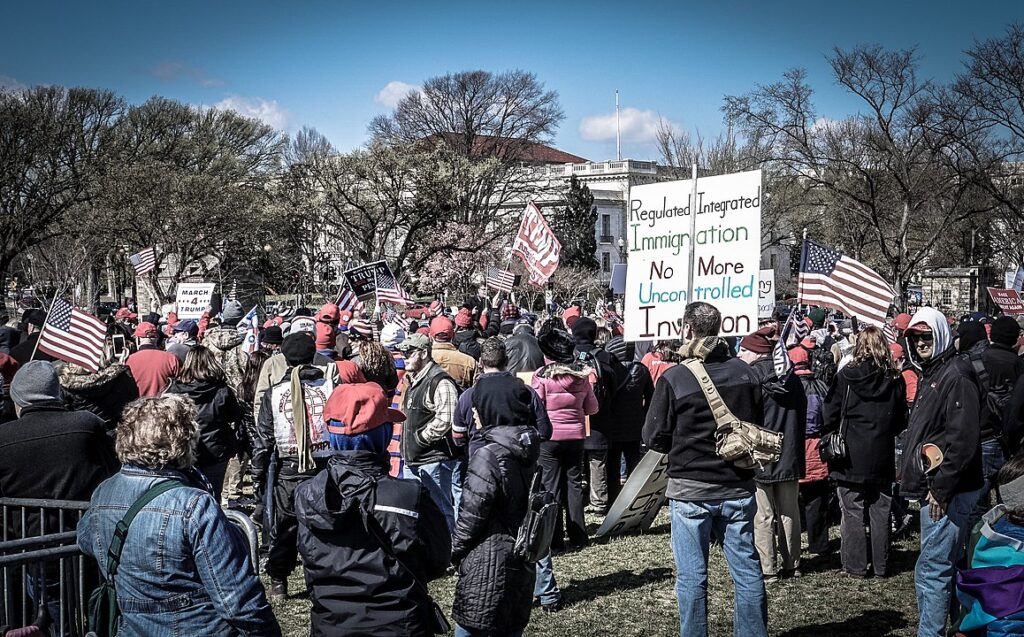Days before the presidential election, a local newspaper reporter writing about the history of immigration politics in the U.S. approached me for a comment. As a historian of the U.S.-Mexico border region, I receive requests like this often. On this occasion, the junior reporter adamantly stated her editors wanted a “neutral” response. They didn’t want to seem biased on the cusp of the election, she said. After a deep breath, I explained that this was an unreasonable, if not impossible, request. Drawing false equivalences for the sake of objectivity is unethical. Attempts at impartiality when it comes to accurately describing the immense cruelty of the U.S. immigration system are not only ahistorical, but a threat to human rights. I assured her our conversation, grounded in historical facts, would encompass issues of immigration, reproduction, demographic shifts, white supremacy, and the future of democracy.

I started with two recent revelations, one about forced hysterectomies of detained migrant women in a Georgia detention center and the other about the government’s inability to locate the parents of 545 children separated at the U.S.-Mexico border, revealing the Trump administration’s continued disdain for migrant people. Historians know that these stories are not anomalies. Rather, they are part of an insidious centuries-long history of a brutal immigration regime, one that racialized migrants through their fertility and sexuality because migrant reproduction threatened the racial supremacy of whites in the United States. I provided these historical receipts—the documentary evidence prohibiting my neutrality—during our chat.
Since its founding, the United States has understood itself, first and foremost, as a nation of white citizens. The Founders enshrined racial slavery in our founding documents, while making sure to safeguard white access to citizenship. In 1790, as one of its first acts, Congress passed a law inscribing the idea that only “free white persons” could become naturalized citizens. Over the next two centuries, the immigration system, and by extension battles over birthright citizenship, became central to understanding “how race is made” in the United States. Restrictive and discriminatory immigration laws such as the Page Act (1875), the Chinese Exclusion Act (1882), and the Johnson-Reed Act (1924) served as racial sieves—separating out undesirable non-white peoples from entering the United States.
In her recent book, America for Americans: A History of Xenophobia in the United States, historian Erika Lee examines the historical trajectory of xenophobia directed first at Native peoples and then at German, Irish, Mexican, Chinese, and Japanese migrants. Due to racialist logics about people’s country of origin—European descendants vs. everywhere else—German and Irish people were assimilated into whiteness toward the end of the nineteenth century, while those latter groups, Mexicans, Chinese, Japanese and by extension South Asian and Central Americans, were inscribed into the national consciousness as perpetual intruders. Country of origin standards, developed under the 1924 Johnson-Reed Immigration Act, were especially egregious for Native peoples and Mexicans who often laid claim to lands once considered theirs before white settler colonization.
At the turn of the twentieth century, eugenicists and nativists wove together concerns for reproduction—from abortion to contraception to the medicalization of birth—with fears about white people’s declining birthrates and the growth of non-white, seemingly more fertile, immigrant groups entering the country. Economist turned sociologist Edward Alsworth Ross was among these fearmongers. Ross vociferously opposed immigration. He was virulently anti-Japanese and believed a return to agrarian life and strict immigration controls would turn the tide of low white birthrates. He famously coined the term “race suicide,” referring to the drop in “native-born” birthrates. Ross believed that in the face of unrestricted immigration of groups “incapable” of integrating into American culture, “the higher race [whites] quietly and unmurmuringly eliminates itself rather than endure individually the bitter competition it has failed to ward off from collective action.”
Ross’s beliefs were not marginal. In 1902, President Theodore Roosevelt echoed Ross’s sentiments citing “race suicide” as an unpardonable crime. Indeed, many read Ross’s work alongside other such luminaries as Madison Grant, author of The Passing of the Great Race (1916), and Theodore Lothrop Stoddard, founding member of the American Eugenics Society and faithful of the Ku Klux Klan, who wrote The Rising Tide of Color Against White World-Supremacy (1920). These works helped to codify fears over the decline in white birth rates and undergirded calls by eugenicists to support “proper breeding.” They advocated for offensive measures by the state, including the proliferation of such prophylaxis as compulsory sterilizations in immigrant-rich states like California. Scholars Natalie Lira and Alexandra Minna Stern determined that from the 1920s to the 1950s, “Mexican-origin patients were sterilized at elevated rates, disproportionate to their share of the state population.” Over 70,000 people were forcibly sterilized in the United States in the twentieth century. Different states used eugenic sterilizations to prevent all manner of “social ills,” such as poverty, illiteracy, sexual promiscuity, mental illness, and alcoholism. These “traits” were racialized as most notably found in non-white migrants, Black or U.S.-born Latinx people or poor whites of “low parentage.”
Not all states passed sterilization laws, but still found ways to stigmatize migrant women’s reproduction. In my own work, I found that Texas, which shares the largest swath of border with Mexico, never instituted a compulsory sterilization law. Instead, they chose a more libertarian approach: supporting the work of birth control pioneer Margaret Sanger. For instance, in El Paso—known to historians as the Ellis Island of the Southwest—upper middle-class white women rallied to establish a birth control clinic for their “largely Mexican community” in 1937. As one birth control advocate declared, “[w]ith our efforts we can make possible the breeding out of human weeds, the breeding in of the strong, the clean, the fit.” Another participant in the movement stated that teaching the virtues of birth control “would be a great asset particularly for the Spanish-speaking population of El Paso.” Less severe, but no less benign than sterilization, the campaign to promote contraception for Mexican-origin women was relentless in El Paso—a majority ethnic Mexican city. While much larger cities like Dallas and Houston struggled to maintain one clinic, by 1945, El Paso had three. Through these measures, Mexican-origin women’s supposed lasciviousness became intimately connected to their “high fertility,” cementing racialist depictions of an out-of-control migrant population.
In the years that followed, reproductive coercion became inextricably linked to the experiences of immigrants or those perceived to be outside the parameters of white American citizenship. From experimentation with contraceptive devices on Puerto Rican women in the 1950s to the forced sterilizations of Chicanas at Los Angeles County-USC Medical Center in the 1960s and early 1970s—documented in the award-winning film No Más Bebés—controlling the “hyper-fertility” of immigrant people became population control by any means necessary.
Attacks against the reproductive health and well-being of migrants continued toward the end of the twentieth century. President Bill Clinton’s Operation Gatekeeper, a ramping up of militarization on the border, and states like California passing Proposition 187, a law denying education and health care to those who could not prove American citizenship, were emblematic of the continued hostilities toward immigrants. Legal wrangling over Prop 187 did not end until 1999, closing out a most contentious century for immigrant rights.
With the rise of technology and an equally matched rabid xenophobia, this century seems to be on par with the last. Echoing California’s contempt for undocumented migrants, Texas state senators tried to take legislation a step further, denying citizenship to babies born to undocumented migrants in the U.S. In 2006, Republican State Representative Leo Berman of Tyler, Texas stated, “An anchor baby comes in with about a half dozen other people, who are now eligible to stay and draw benefits.” The term “anchor baby” became synonymous with an ever-growing anger among white Americans that undocumented migrants were stealing resources such as welfare and healthcare via birthright citizenship. Anxieties about “anchor babies” never went away; Donald Trump harkened back to this very issue in 2018 when he threatened to sign an executive order denying citizenship to children born to non-citizen parents in the U.S.

And yet, under Democratic and Republicans administrations, xenophobic legislators have derailed paths to citizenship for the nearly 11 million undocumented people living in the shadows. In a bipartisan manner, both parties managed to further militarize the U.S.-Mexico border, financing the expansion of Homeland Security and ICE. Since at least 2012, the government continues to spend more money on immigration restriction, surveillance, and detention than it does on the FBI. This includes the proliferation of detaining migrant families in squalid conditions at detention centers across the country. Obama was not only known as the “Deporter-in-Chief,” but his administration also provided the infrastructure the Trump administration has so ruthlessly exploited since 2017. This was brought into stark relief two weeks ago when President-elect Joe Biden named Cecilia Muñoz, who justified family separations under the Obama administration, to his transition team.
Still the Trump administration’s obsession with reproductive violence, particularly targeting migrant women and children, seems in line with Ross, Grant, and Stoddard’s immigration philosophy over a century ago. Notes taken during meetings discussing the administration’s child separation policy reveal attorney general Jeff Session’s eagerness to “take away children” from their asylum-seeking parents. At the same time, Trump appointed anti-abortion administrators like Scott Lloyd to head the offices of refugee resettlement. Lloyd took the unprecedented step of monitoring the menstrual cycles of countless young women in his care as they reported sexual violence and rape during their journeys to the U.S. border, often forcing them to continue with pre-natal care as some demanded their constitutional right to an abortion.
In the wake of recent allegations of forced hysterectomies of detained migrant women and the administration’s inability to locate the parents of more than 545 children separated at the border, it remains crystal clear that suppressing reproductive freedom is a crucial marker of immigration policy in the United States. In late October, the House Judiciary Committee released a damning report of Trump’s Family Separation policy. Judiciary Committee Chairman Jerrold Nadler (D-NY) and Immigration Subcommittee Chair Zoe Lofgren (D-CA) stated unequivocally that “the Trump Administration has failed to reunite hundreds of children with their families. The incompetence is unforgiveable. As we move forward, we need a whole of government approach to reunite these families and put an end to this dark chapter in our nation’s history.” The following day, the New York Times reported the Trump administration released an unspecified number of children from other countries to Mexico stretching the limits of “immigration and child welfare laws” and, I would argue, human rights as well.
Even in the midst of losing re-election, the Trump administration continues to double down on their merciless policies, including the deportation of 50 Cameroonian asylum seekers who said ICE agents tortured them into signing self-deportation orders. But, again, pushing the narrative that our national borders are to be protected at all costs from non-white immigrants—parents, potentially fertile women, and children—is not new. Stephen Miller, Trump’s White House and re-election campaign advisor, has worked tirelessly to make cruelty key to Trump’s immigration strategies, using history as his guide.
What animates the Trump administration today is a ramped-up version of what animated eugenicists and white supremacists a century ago: anger, resentment, and fear that demographic shifts through immigration and reproduction will soon make whites a minority. Reproductive justice scholar and activist Loretta Ross similarly explains that “These men suffer from majoritarian insecurities, believing they are under siege from hordes of non-whites who threaten their control over America.” As Ross notes, these white men are not wrong. By some estimates the U.S.’s white population will become a minority by 2045. As Latina scholar Cristina Beltran contends, white Americans see these shifts as an attack on white democracy. Beltran defines white democracy as the freedom to inflict violence, exert control, and subordinate racialized others. Thus, to disregard our present immigration moment for the sake of neutral news coverage is to deny reality in the service of white supremacy and the protection of white democracy.
 Lina-Maria Murillo is Assistant Professor in the departments of Gender, Women’s, and Sexuality Studies and History at the University of Iowa. She is completing her first book titled Fighting for Control: Reproductive Care, Race, and Power in the U.S-Mexico Borderlands. She examines the tensions between advocates for population control and those committed to greater reproductive access for the majority Mexican-origin women in the borderlands. She focuses on the history of Planned Parenthood’s population control rhetoric that racialized Mexican-origin women’s reproduction and shines a light on the unknown history of Chicana activism that challenged racialist reproductive health tropes in the movement. She tweets from @LinaMariaMuril6
Lina-Maria Murillo is Assistant Professor in the departments of Gender, Women’s, and Sexuality Studies and History at the University of Iowa. She is completing her first book titled Fighting for Control: Reproductive Care, Race, and Power in the U.S-Mexico Borderlands. She examines the tensions between advocates for population control and those committed to greater reproductive access for the majority Mexican-origin women in the borderlands. She focuses on the history of Planned Parenthood’s population control rhetoric that racialized Mexican-origin women’s reproduction and shines a light on the unknown history of Chicana activism that challenged racialist reproductive health tropes in the movement. She tweets from @LinaMariaMuril6

NOTCHES: (re)marks on the history of sexuality is licensed under a Creative Commons Attribution-NonCommercial-NoDerivatives 4.0 International License.
Based on a work at www.notchesblog.com.
For permission to publish any NOTCHES post in whole or in part please contact the editors at NotchesBlog@gmail.com




